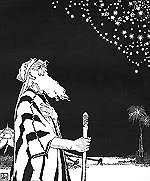
Once Upon a Time... Charles Perrault, Histoires ou contes du temps passé, 1697: The Wolf, from Little Red Riding Hood
The Fear Factor in Post-Biblical Imagery
Images of Otherness, Prejudices, and Stereotypes
a. Law of segregation: canon or apocrypha?
b. Fruits of Divorce: Prejudices
c. Stereotype: the shortest way, but to where?
d. Author and Aim
e. Social Psychology and the big Why: Individual and Society

Disconnection Time
Stereotype. A stereotype is a popular belief about specific types of individuals. Stereotypes are standardized and simplified, rigid conceptions of groups based on some prior assumptions. The term stereotype derives from the Greek words στερεός (stereos), "firm, solid," and τύπος (typos), "impression," hence "solid impression"; in 1850 English it means "image perpetuated without change" (Online Ethimology Dictionary).
Sociologist Charles E. Hurst explains that "one reason for stereotypes is the lack of personal, concrete familiarity that individuals have with persons in other racial or ethnic groups. Lack of familiarity encourages the lumping together of unknown individuals." Stereotypes focus upon and thereby exaggerate differences between groups. Competition between groups minimizes similarities and magnifies differences. Reliance on stereotypes appears to be heightened with increased exposure to stereotypes, regardless of whom the stereotype is portraying.
A theory as to why people stereotype is that it is too difficult to take in all of the complexities of other people as individuals. Even though stereotyping is inexact, it is an efficient way to mentally organize large blocks of information. Categorization is an essential human capability because it enables us to simplify, predict, and organize our world. Once one has sorted and organized everyone into tidy categories, there is a human tendency to avoid processing new or unexpected information about each individual. Assigning general group characteristics to members of that group saves time and satisfies the need to predict the social world in a general sense.
Possible prejudicial effects of stereotypes are:
1. Justification of ill-founded prejudices or ignorance
2. Unwillingness to rethink one's attitudes and behavior towards stereotyped group
3. Preventing some people of stereotyped groups from entering or succeeding in activities or fields
Is this ad objectionable? Yes? No? Why?
Stereotypes involve the exaggeration of certain features or characteristics of "the other," with the specific purpose of emphasizing the "otherness" so to convey the idea that the "other" is something else than human (less than human, ridiculous, pathetic, disgusting, monstrous, inhuman).
Stereotypes tend to dehumanize "the other" and legitimize patterns of prejudice, disrespect, segregation, discrimination, and violence.

Brook Andrew, Sexy and Dangerous, digital image, 1996
The Exotic Human: Other Cultures as Amusement. Klulsy Lamko reviews a 2009 exhibition at Teylers Museum, Haarlem (NL), and Museum Guislain, Ghent: "What with the creationists and the evolutionists, prejudice decidedly still has a lot of life left in it. An intriguing question, the origin of man! [...] The exhibition, which brings together posters, photographs, masks, colonial objects, sculptures, documentaries, books, etc. in a formal post-modern perspective, boldly returns to the theme of the perception of Otherness as promulgated for centuries in Europe. Tribes of Africans, Indians, Aboriginees, Greenlanders, Samoans and Pakistanis, huts, forests, temples, slavery, the 1897 Colonial Exhibition in Tervuren, scientific expeditions, craniometry, anthropometry, the Hottentot Venus, the colour chart, DNA – in a word, biology, culture and history – are cheerfully jumbled together, revealing the commonalities on which racism, slavery, colonisation and apartheid were founded. In a nutshell, Others, because they are different, are animals, or almost: they are in a state of nature, ugly, bizarre, comic, savage, violent, devoid of reason, cannibals – in a word, for all these reasons, exotic!

Robert Crumb, Angelfood McSpade: "She's All Heart." c. 1970
What is the purpose of such a daring exhibition on this sensitive subject? The answer is complex. To hold up a mirror, to confront us with our own history? The aim of educating and reminding us is undoubtedly laudable. Indeed, if it invites us to look twice, in other words to examine the unhealthy, hierarchical, destructive attitude to Others, if it leads us to question the stupidity of pseudo-scientific attempts at racial characterisation and hierarchal organisation, if it elicits from visitors not an amused smile (short of an unusual capacity for self-ridicule) but a grimace of disgust, we can feel reassured.
Conversely, if, instead of being perceived as a scathing denunciation, the exhibition confirms visitors in their stereotypes, it would be monstrous. There is nothing against being entertained, but because of the multiple meanings that images can have, a good deal of care is called for in the way objects are presented (in this case a unilateral point of view, lifeless legends, heterogeneity, etc.) – especially when conjuring up the muddy swamp where human thought has become bogged down in justifying atrocities. It is not so long since the colonial era when, by dint of imposing rules and measuring legs and noses, the social categories Tutsi and Hutu were transformed into rival ethnic groups, thus laying the foundation for the genocide of the Tutsis in Rwanda. James Watson’s racist arguments are still current. There is still a danger of being drawn into a progression: you become a scientific profile, a negroid type, an anthropological debate, a photographic subject."
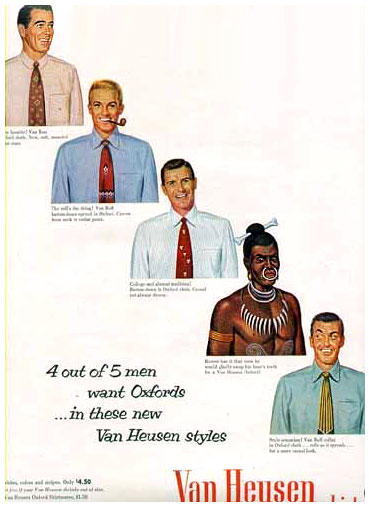 |
| "Four of five men want Oxfords in these new Van Heusen styles" Discriminatory shirts ad, U.S., 1952 (Gawker) |
"But what is a black? And, first of all, what color is his color?" —Jean Genet, playwright, 1910-1986
 |
| "Why doesn't your mamma wash you with Fairy Soap?" Racist soap ad, U.S., undated (Oddee) Racism in the United Sates |
"Biological laws tell us that certain divergent people will not mix or blend. The Nordics propagate themselves successfully. With other races, the outcome shows deterioration on both sides." —Future US president Calvin Coolidge, "Whose Country is This?," Good Housekeeping, 1921, 14.
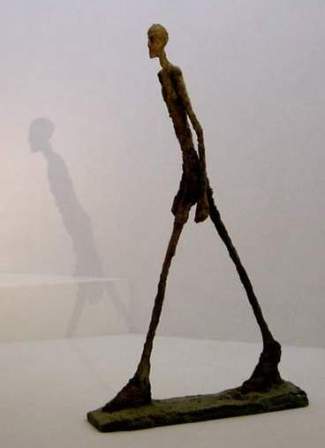 |
| Alberto Giacometti, Walking Man, bronze, 1960 |
The Portrayal of Jews. Stereotypes are generalizations and Jewish people have been stereotyped for over two millennia throughout Europe and the Western hemisphere as scapegoats for a multitude of societal problems (Mortimer Ostow, Myth and Madness: the Psychodynamics of Antisemitism, Transaction Publishers, 1996, p. 61). Antisemitism continued throughout the centuries and reached a climax in the Third Reich during World War II.
Jews are stereotyped as greedy. In caricatures and cartoons, they are depicted having large hook-noses, thick lips, curly hair, large dark-colored eyes, olive brown skin, and wearing hats or kippahs.[1] They are shown as evil, deceitful outsiders, greedy and repulsive.[2]
The portrayal of Jews as historic enemies of Christianity constitutes the most negative stereotype and is reflected in the imagery of the late-10th through early-12th centuries, where they appear as menacing and satanic. Although Jews had not been particularly associated with moneylending in Antiquity, a stereotype of them acting in this capacity was developed beginning in the 11th century. As Jews were forbidden from owning land by the church, many went into money-lending and usury. This led to, through the Middle Ages and the Renaissance, the association of Jews with greedy practices. Jonathan Frankel notes that this stereotype, though obviously an exaggeration, had a solid basis in reality: while not all Jews were moneylenders, it does seem to have been true that Jews were disproportionately represented in the trade (The Fate of the European Jews, 1939-1945: Continuity or Contingency?, Oxford UP, 1997, p. 16). Publications such as William Shakespeare's The Merchant of Venice (1596-98), Charles Dickens's Oliver Twist (1838), and The Protocols of the Elders of Zion (1903) reinforced the stereotype of the crooked Jew.
In nineteenth-century English literature, the most common portrayal of a Jew was a negative racial stereotype. In society, and thus in literature, Jews were often seen in terms of their "otherness"—their difference in appearance, social standing, religion and values with respect to their non-Jewish counterparts. This is especially true of the fiction of the early nineteenth-century when the ghost of Shakespeare’s greedy, evil Shylock still haunted English literature. However, even when Jews gained political equality in England with the passage of numerous reforms and a rise in realism in fiction caused novelists writing in the mid-1800s to look increasingly to real life rather than to established stereotypes as inspiration for their writing, Jews were portrayed in exaggerated terms as completely evil or impossibly virtuous; as wealthy politicians and international financiers or lowly impoverished immigrants; as people seeking complete assimilation into English culture or as adamantly separatist.
Sir Walter Scott produced the first novel-length treatment of Jewish characters in Ivanhoe (1819), but Charles Dickens was to engender one of the most influential examples of the stereotypical "evil Jew"—the character of Fagin in Oliver Twist (1838). Significantly, "the image of the Jew in English literature has been a depressingly uniform and static phenomenon" (Edgar Rosenberg, 1960). That phenomenon is mostlyt due to Dickens.
Western stereotypes of Jews portray them in the negative terms of money-mad.[3][4] The stereotype "all Jews are rich" has been a staple for anti-Semitism for centuries. This stereotype is not used to tell people how hard Jews work, or how smart they are, but to portray them as thieves. In the U.S., public opinion polls taken from the mid-1930s to the late-1940s showed that over half the American population saw Jews as greedy and dishonest. Those polls also indicated that many Americans believed that Jews were too powerful in the United States. Although only 0.6 percent of the nation's 93,000 commercial bankers in 1939 were Jewish, the idea that Jews controlled the banking system remained a popular myth. Besides, stereotypes were not so much rooted in religion as they were in envy, jealously and fear of Jewish affluence (and of the hidden power of "Jewish money").
Shakespeare gives Shylock one of his most eloquent speeches: "Hath not a Jew eyes? Hath not a Jew hands, organs, dimensions, senses, affections, passions? ... If you prick us do we not bleed? If you tickle us, do we not laugh? If you poison us, do we not die? And if you wrong us, shall we not revenge?" (Act III, scene I)
Al Pacino on Shylock: “I was able to see those human elements of the character. I started to understand the motivation. [...] I didn’t know how I would approach it. But I saw a character that I could understand and identify with.” Pacino acknowledges that it’s not a simple play with a simple theme. When asked what he perceives to be the play’s message, he pauses, and then says “tolerance.” After a second, longer pause, he says, “It’s a difficult play to relate to. There are aspects that I relate to. And certainly Shylock’s condition, his dilemma, his plight, I relate to that. I can only speak from that character. I really can’t tell you too much about my feelings for the whole play. I have ambivalent feelings about different aspects of it” (Interview by Jeff Wilser, 2008; TCS).
 |
| Mariano Akerman, Prickly Matters (453 Grams of Living Matter), 2009 The Merchant of Venice has long provoked controversy, though one argues it can be interpreted as a plea for mutual respect. |
"I am always asked whether or not Jews have a 'Semitic' nose. After 54 years of experience I can only answer that every Jew I have ever met has a nose!" —Sander L. Gilman, historian, 1944
 |
| The nineteenth-century "Aryan" Jesus and his recent "Semitic" counterpart look simplistic as soon as one compares them with Rembrandt's seventeenth-century Portrait of a Young Jew as Christ. |
Stereotypes shape the picture that we have of ourselves and of "others." They are simplifications which supposedly help us to understand a complex world and to overcome our fear of the unknown. At the same time, they provide material for racist ideologies. One may well question how such ascriptions and characterizations arise.
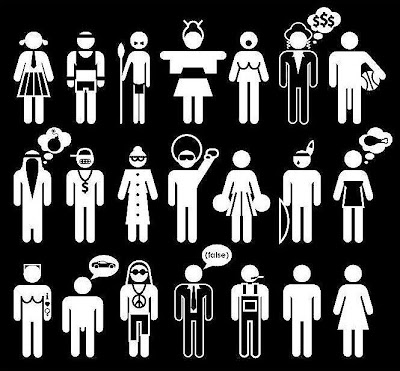 |
| A collection of stereotypes |
Typical! is a 2008-11 exhibition about the stereotyped seeing, perceiving, and compartmentalizing of images and objects. Stereotypes and clichés are an integral part of our perception that shapes our image of ourselves and of "others" and our sense of belonging to a group or a nation separate from other groups and nations. It’s impossible to imagine pop culture without characterizations and classifications, which through their simplification may help us to overcome our fear of the unknown, but at the same time can also provide us with a breeding ground for racist ideologies (JMB).
"I'm astound by people who want to 'know' the universe when it's hard enough to find your way around Chinatown." —Woody Allen, American film director
Stereotyping in media. Not all stereotyping is bad. Stereotyping arises out of the need to generalize in order to make sense out of a very complicated environment. It allows people to easily categorize new things into comfortable spaces already defined by their experiences. This process was described in 1922 by Walter Lippmann, who first coined the term "stereotyping." Lipmann wrote, "the attempt to see all things freshly and in detail, rather than as types and generalities, is exhausting, and ... practically out of the question" (Public Opinion).
The media uses stereotypes as a shorthand method of defining characters in ways that are easy for people to identify and categorize. What these stereotypes all have in common is that they reduce to a one-sided, superficial and exaggerated depiction the real variety, depth and complexity of a people. Negative stereotyping arises out of an ethnocentric view of the world; ones own group is the center of everything and all other groups are rated in reference to it. Negative stereotypes are prejudicial judgments that assign negative qualities to other groups.
Because stereotypes often contain a "kernel of truth" (they may be characteristic of some or many members of a group) they are widely accepted as the truth. However, specific tendencies that may be widespread among a group should never be applied to every member of a group. That's because the stereotypes generalize individuals within a group, emphasizing sameness and ignoring individual variety.
Repetition tends to normalize stereotypes, because repeating stereotypes validates and perpetuates them. When members of one group think about members of another group as "bad" or worse, sub-human, they are likely to inflict harm upon them. Racist stereotypes can even justify actions that would normally be unimaginable, as was the case with Germany during WWII. Hitler's anti-Semitism could never have precipitated the Holocaust if Germans didn't already have a long history of anti-Semitic beliefs and actions. The repetition of negative racial stereotypes about Jews and other so-called "undesirables" ultimately propelled ordinary Germans to systematically kill millions of innocent human beings.
Negative racial stereotyping was used by all sides during WWII to demonize enemies. Racist stereotypes were also used to justify a steady stream of civilian deaths and crimes against humanity, and the US was no exception. The firebombing of Dresden and Tokyo as well as the atomic bombs that were dropped on Japan caused human slaughter on a massive scale. Ordinary Americans believed these actions were justified because of the negative stereotyping of America's enemies that preceded the war, and the more virulent forms that emerged during the war.
The media today is more sensitive to issues of culture and gender than it once was, but the creation and perpetuation of common misconceptions about groups of people continues. Oversimplified and inaccurate portrayals have profoundly affected how we perceive one another, how we relate to one another and how we value ourselves (racist-stereotypes.com).
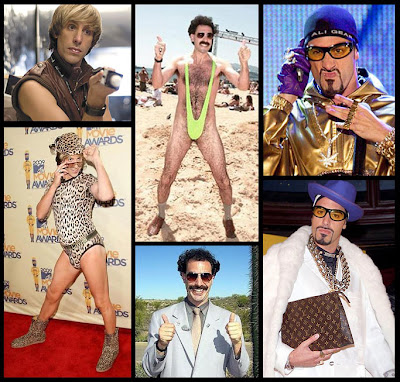 |
| Baron's stereotypes in extremis: Brüno, Bórat, and Ali G. |
Resources
Estereotipo
Sociological Images
Invoking the Primitive
Sambo in racist cartoons
Sinophobia
Stereotypes in Disney's work
Lo familiar vuelto inquietante





